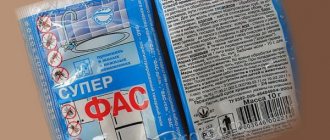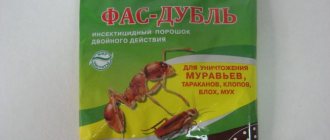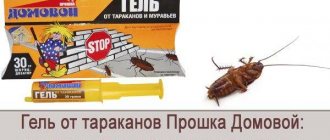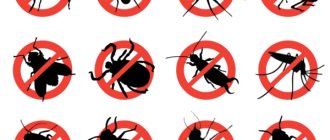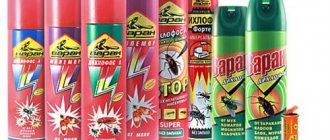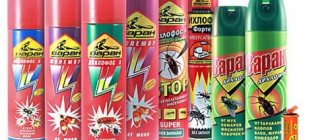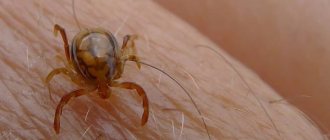Physical and chemical properties
Chlorpyrifos in its pure form appears as white crystals. The product is stable in acidic and neutral environments. At the same time, it quickly disintegrates under the influence of alkalis.
The main physical characteristics of the product include:
- steam pressure – 1.9∙10-5 millimeters of mercury;
- melting point – 41.5-43.5 degrees;
- molecular weight – 350.6.
Solubility indicators differ depending on the liquid:
- in water at a temperature of 25 degrees – 2 milligrams per 1 liter;
- in benzene – 7900 grams per 1 kilogram;
- in acetone – 6500 grams per 1 kilogram;
- in ethanol – 630 grams per 1 kilogram;
- in xylene – 4000 grams per 1 kilogram.
Effect on harmful mechanisms
When parasites enter the body, chlorpyrifos phosphorylates a number of substrates. One of them is considered to be a protein enzyme that is present in nerve tissues. It is called acetylcholinesterase. This substance plays an important role in the transmission of nerve impulses.
The active component belongs to the category of carboxylic acid ester hydrolases. It is predominantly located on the postsynaptic membrane of the synapse and is part of the axon membrane.
Expert opinion
Zarechny Maxim Valerievich
Agronomist with 12 years of experience. Our best country expert.
Ask a Question
Chlorpyrifos and organophosphorus substances, when interacting with esterases, provoke a suppression of their activity. Such elements act as competitive inhibition. Acetylcholinesterase is responsible for the hydrolysis of acetylcholine. As the enzyme is blocked by chlorpyrifos, an accumulation of acetylcholine is observed in the synaptic cleft. This causes a disruption in the transmission of nerve impulses.
As a result, convulsions develop, turning into paralysis. When chlorpyrifos enters the insect's body through the respiratory system, stomach or integument, acetylcholinesterase activity decreases. The product allows you to get rid of bedbugs. It also helps against ants and cockroaches.
See also
Preparations related to pesticides and which type of pesticide is better to chooseRead
Chlorpyrifos is considered more persistent than other organophosphorus elements. Therefore, it exhibits a noticeable intestinal effect. The longer the substance remains active, the more effective it is against gnawing pests. The duration of the effect of the product reaches 40-70 days. The substance remains in the soil for 60-120 days. There is also information that the active component can remain stable in the soil for 2 years.
With the systematic use of chlorpyrifos-based products, group resistance to it develops in some types of parasites.
Scientists and social activists criticized Chlorpyrifos
Clean Label Project experts spoke about the risks to human health posed by the rapidly growing popularity of the pesticide Chlorpyrifos and why it cannot become a full-fledged replacement for the more common glyphosate.
One of the most common pesticides in the world today remains the composition produced under the RoundUp brand. Its active ingredient glyphosate is excellent at controlling a wide range of weeds. It was registered as a pesticide back in 1974 - and still retains a significant share of the market for agricultural pesticides. However, glyphosate has come under widespread criticism in recent years due to its designation by the World Health Organization (WHO) as a "probable carcinogen".
In May 2021, a California court awarded more than $2 billion to a couple who claimed Bayer AG's glyphosate-based weed killer caused their cancer. To date, this is the largest verdict in any chemical litigation in American court practice.
Some lawyers argued that the settlement amount may not have been so impressive. However, this would be of little help to Bayer, which is currently in a state of legal crisis. In June of this year, it acquired Monsanto and its RoundUp brand for $63 billion - and in addition inherited the lawsuits brought against Monsanto (more than 13,000 cases).
However, claims against glyphosate are not limited to American shores. On September 4, 2021, Germany said it would gradually reduce its use of the controversial pesticide and phase it out completely by 2023.
Observing the regulatory, legal and consumer battle between the public and glyphosate, as well as the differences between the decisions of the official court and the court of public opinion, raises the natural question: “What next?” Are there other pesticides that are equally effective and at the same time safe for humans? Can existing risks be accepted?
Theoretically, such an alternative could be chlorpyrifos, which is an organophosphorus compound. Its key advantage lies in its complex action: it is an insecticide, an acaricide, and a miticide. It is mainly used to control weeds and soil-dwelling insect pests and is suitable for a variety of food and feed crops.
However, the possibility of using this pesticide is highly questionable. In August 2021, the European Food Safety Authority stated that no safe exposure level could be established for chlorpyrifos. This means the EU is unlikely to renew the authorization for chlorpyrifos after the current authorization expires in January next year. This decision by the European Commission goes against the policy of the US Environmental Protection Agency - in July 2021, the American agency said that it does not plan to ban chlorpyrifos.
Meanwhile, US consumer advocacy group Earthjustice has been campaigning for several years to ban chlorpyrifos due to its links to low birth weight, lower IQ, working memory loss, attention problems and delayed motor development in children. And under public pressure, the Environmental Protection Agency (EPA) revised its November 2021 assessment of the effects of chlorpyrifos on human health, confirming that there is not and cannot be a safe use standard for this pesticide.
Considering the above, it can be argued that the use of chlorpyrifos creates significant risks for the brand and may undermine consumer confidence. Despite the fact that at the moment there is no consensus among the world community regarding the possibility of using chlorpyrifos, American experts are confident that in the near future the demand for this pesticide will significantly decrease.
The best drugs based on chlorpypiphos
The substance is present in the following pesticides used in agriculture:
- "Nurbel";
- "Dursban";
- "Nurimet";
- "Sail".
The following substances are usually used in everyday life:
- "Sinuzan";
- "Maxifos";
- "Xulat";
- "Sichlor."
Rules of application
When using drugs based on this substance, it is important to follow the instructions. It is recommended to take into account the type of crops being processed:
- Winter rapeseed. It is best to carry out processing in the fall. The product will help destroy cabbage cutworm larvae, moths and other parasites. In spring, the composition is applied before the formation of buds.
- Winter grain plants. In this case, it is worth using the product in autumn and early spring. It helps to cope with bread ground beetle larvae. It is worth completing the processing by the time the ear emerges.
- Peas. The drug helps to destroy gray beet weevils and bruchus. It should be used at the budding stage.
- Sunflower. The product is used to destroy the larvae of winter cutworms and aphids.
- Corn. The composition successfully copes with the larvae of the corn moth and cotton bollworm. The substance should be used before flowering begins.
Chlorpyrifos: you want it and it hurts
Almost a year has already passed since the use of chlorpyrifos and chlorpyrifos-methyl was banned in Europe, and the import into EU countries of agricultural products containing residues of these substances of more than 0.01 mg/kg is also prohibited. Despite this, insecticides based on them remain popular among manufacturers because of their effectiveness against an extremely wide range of pests - both insects and mites, and the fumigant effect of the drug “gets” them where contact and systemic drugs do not work, for example in soil. In Ukraine, these products are not yet prohibited, but some producers, since most products are exported, are afraid to use these drugs on their crops. Are these fears justified? Will there really be residues in the products after treatment with this insecticide? To answer this question, you need to know what chlorpyrifos is.
The history of use of this compound is long. His first appearance on the fields took place back in 1965. Chlorpyrifos belongs to a large family of organophosphorus compounds, abbreviated as FOS, and is an insecticide with contact-intestinal and fumigant action. Among the compounds of this group, some are systemic preparations, the active substances of which penetrate inside the plant and follow the sap flow to the growth points (for example, dimethoate), and this really poses a threat that during late treatments some of the insecticide may remain in the product, which is why These drugs have a limitation for the last application (at least 30 days before harvesting). In contrast, chlorpyrifos is a local-systemic insecticide; it penetrates the outer layer of cells, but does not move throughout the plant, therefore it protects only those parts of the plant to which it was applied. This feature makes it impossible for it to enter the product if the treatment was carried out before its appearance, for example, into wheat grain, if the application was carried out before the ear emerged, or into apples, when processed before flowering.
Another property of chlorpyrifos is its fumigant effect (penetration of drug fumes into the body of pests through the respiratory system) - also successfully used to combat secretive pests, aphids, mites and, especially, larvae of ground beetles and winter cutworms. The half-life of the active substance in the soil is 21 days, that is, it is unstable, solubility in water is very low - 1.05 mg per liter, so it does not enter the plant with water and is not leached (not washed). Based on this, the introduction of chlorpyrifos into the soil during treatment against ground beetles and fall armyworms does not harm the environment or the future harvest. On the other hand, when some owners, contrary to recommendations, using its fumigant property, treat warehouses with chlorpyrifos, the grain comes into direct contact with the treated surface and may subsequently contain residues of the drug.
Based on the information provided, the following recommendations can be made for the safe use of chlorpyrifos-based drugs:
Winter rapeseed. Treatments in the autumn against the larvae of the fall armyworm, cabbage moths, cabbage cutworms and other pests characteristic of this period will certainly be safe. In spring, treatment with the drug should be carried out before budding begins.
Winter grain crops. Chlorpyrifos remains most effective in combating bread ground beetle larvae in autumn and early spring. Treatments against other pests should be completed by the time the ear emerges.
Peas . The insecticide can be used to control seedling pests, for example, gray beet weevil and bruchus, during the first treatment during the budding phase.
Sunflower - to combat the larvae of the summer generation of the winter cutworm, pests of seedlings (weevils, weevils) and aphids to the star stage.
Corn - to combat the larvae of the summer generation of the winter bollworm in the germination phase, with the larvae of the cotton bollworm and corn moth, before flowering.
Apple and other fruit trees - treatment before flowering.
In conclusion, I want to say that, given the wide range of controlled pests, high efficiency, and affordable price, chlorpyrifos has not yet exhausted its potential as a plant protection product. To paraphrase the expression of Paracelsus: “Everything is poison, everything is medicine, the dose determines both,” we can say that chlorpyrifos can be beneficial or harmful, depending on when and how to use it.
Gennady Podpalny, agronomy researcher at Agrosfera .
You can order products and receive qualified advice by calling the hotline 0
or on the website.
